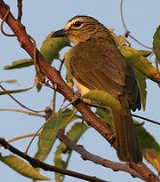
White-browed Bulbul
Encyclopedia
The White-browed Bulbul ( Pycnonotus luteolus) is a member of the bulbul
family of passerine
bird
s. It is a resident breeder in Sri Lanka
and peninsular India
. Largely olive coloured above with whitish underparts, it has a pale supercilium and a yellow vent. They are found in dense scrub habitats, where they skulk within vegetation and can be difficult to see although their loud and distinct burst of calls is distinctive.
_drinking_water_w_img_7782.jpg) The White-browed Bulbul is about 20 cm (7 inches) in length, with a moderately long tail. It has olive-grey upperparts and whitish underparts. This species is identifiable by the white supercilium, white crescent below the eye, and dark eyestripe and moustachial stripe. The vent is yellowish and there is some yellow on the chin and moustache. The throat is however largely whitish unlike in the similar looking and sounding Yellow-throated Bulbul
The White-browed Bulbul is about 20 cm (7 inches) in length, with a moderately long tail. It has olive-grey upperparts and whitish underparts. This species is identifiable by the white supercilium, white crescent below the eye, and dark eyestripe and moustachial stripe. The vent is yellowish and there is some yellow on the chin and moustache. The throat is however largely whitish unlike in the similar looking and sounding Yellow-throated Bulbul
which is found in rockier habitats. Three or four hair-like filoplumes are present on the nape. Sexes are similar in plumage. It is usually detected by the burst of song that it produces from the top of a bush and often dives into the bush becoming difficult to see. The song is a rich, spluttering warble and the bird is more often heard than seen. The nominate form is from southern India while insulae from Sri Lanka is slightly darker and has a shorter wing.
Individuals may live for more than 11 years.
Bulbul
Bulbuls are a family, Pycnonotidae, of medium-sized passerine songbirds. Many forest species are known as greenbuls. The family is distributed across most of Africa and into the Middle East, tropical Asia to Indonesia, and north as far as Japan. A few insular species occur on the tropical islands...
family of passerine
Passerine
A passerine is a bird of the order Passeriformes, which includes more than half of all bird species. Sometimes known as perching birds or, less accurately, as songbirds, the passerines form one of the most diverse terrestrial vertebrate orders: with over 5,000 identified species, it has roughly...
bird
Bird
Birds are feathered, winged, bipedal, endothermic , egg-laying, vertebrate animals. Around 10,000 living species and 188 families makes them the most speciose class of tetrapod vertebrates. They inhabit ecosystems across the globe, from the Arctic to the Antarctic. Extant birds range in size from...
s. It is a resident breeder in Sri Lanka
Sri Lanka
Sri Lanka, officially the Democratic Socialist Republic of Sri Lanka is a country off the southern coast of the Indian subcontinent. Known until 1972 as Ceylon , Sri Lanka is an island surrounded by the Indian Ocean, the Gulf of Mannar and the Palk Strait, and lies in the vicinity of India and the...
and peninsular India
India
India , officially the Republic of India , is a country in South Asia. It is the seventh-largest country by geographical area, the second-most populous country with over 1.2 billion people, and the most populous democracy in the world...
. Largely olive coloured above with whitish underparts, it has a pale supercilium and a yellow vent. They are found in dense scrub habitats, where they skulk within vegetation and can be difficult to see although their loud and distinct burst of calls is distinctive.
Description
_drinking_water_w_img_7782.jpg)
Yellow-throated Bulbul
The Yellow-throated Bulbul is a species of bulbul endemic to southern peninsular India. They are found on scrub habitats on steep, rocky hills many of which are threatened by granite quarrying. It is confusable only with the White-browed Bulbul with which its range overlaps but is distinctively...
which is found in rockier habitats. Three or four hair-like filoplumes are present on the nape. Sexes are similar in plumage. It is usually detected by the burst of song that it produces from the top of a bush and often dives into the bush becoming difficult to see. The song is a rich, spluttering warble and the bird is more often heard than seen. The nominate form is from southern India while insulae from Sri Lanka is slightly darker and has a shorter wing.
Distribution and habitat
This species is endemic to southern India and Sri Lanka. The northern boundary is along Gujarat, Madhya Pradesh and western West Bengal (near Midnapur). It is found in dry open scrub country but also occurs in gardens and woodlands with dense shrubbery.Behaviour and ecology
White-browed Bulbuls are usually seen singly or in pairs. They forage within bushes for fruit, nectar and insects. The breeding season is spread out from March to September and may possibly breed twice a year. Peaks in breeding occur in February and again in September. The dry season of May to July appears to be avoided for breeding in the Point Calimere region. They build a nest, a loose cup made of twigs, cobwebs and hair placed low in a thick bush and usually on the periphery. Two eggs form the typical clutch.Individuals may live for more than 11 years.
Other sources
- Vijayan, VS (1975) Ecological isolation of bulbuls (Family Pycnonotidae, Class Aves) with special reference to Pycnonotus cafer cafer (Linn.) and Pycnonotus luteolus luteolus (Lesson) at Point Calimere, Tamil Nadu. Ph.D. Dissertation, University of Bombay, Bombay.

